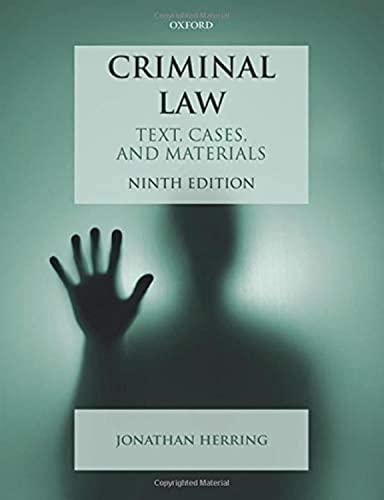Question
4th Amendment: The Fourth Amendment forbids arbitrary seizure and search powers. 5th Amendment: People have a number of rights in both criminal and civil procedures
4th Amendment: The Fourth Amendment forbids arbitrary seizure and search powers. 5th Amendment: People have a number of rights in both criminal and civil procedures under the Fifth Amendment. Due process and the right to a grand jury are two examples. It also forbids double jeopardy and enables persons to shield themselves from self-incrimination. 6th Amendment: Criminal defendants are guaranteed a number of rights by the Sixth Amendment, including the right to an unbiased jury, a counsel, and a prompt trial. Along with knowing the substance of the allegations and evidence against them, it also provides defendants the right to know who is accusing them.
8th Amendment: The federal government is not allowed to impose exorbitant bail, excessive fines, or cruel and unusual penalties in accordance with the Eighth Amendment.
1.) Describe the significance and intent of these four amendments.
2.) Give examplesof how the amendment affects a player and a criminal justice procedure step to demonstrate its application.
3.) Provideillustrationsof how the change relates to the specific participant and stage in the criminal justice process, drawn from case law or recent publications.
4.) The 3Ps of Criminal Justice: Players, Process, and Procedure In each Amendment. (Law Enforcement/The Courts/Corrections
done the 4th Amendment already. Here is what I have:
Amendment/Interpretation/Importance: According to the 4th Amendment, "a warrant shall only be issued upon probable cause, supported by an oath or affirmation, and particularly describing the place to be searched, and the persons or things to be seized." People's right to be secure in their person, homes, papers, and effects against unreasonable searches and seizures shall not be violated.(Source,1)
The Fourth Amendment safeguards individuals from being subjected to unjustified searches and seizures of their person, assets, and possessions. Warrants are also included. It establishes standards, for instance, for issuing warrants. Warrants must be issued by a court or magistrate, and they must be supported by evidence and an oath of office.
It would be challenging to live under a government that possessed such enormous power. Thus, the 4th Amendmentwhich shields individuals against arbitrary and warranted searcheswas drafted by the founding fathers.
Player/Step/Example/: Law Enforcement/Prelim Investigation
example: under oath, police officers have obtained comments concerning the whereabouts of a robbery suspect from an informant. The informant's remarks and the eyewitness accounts lead the cops to suspect that evidence is there at a certain spot. They appear before the judge with their proof and ask for a search warrant for that particular site. The judge then makes a decision in light of the evidence.
Example from Case Law or Contemporary Article. (This database will help you column: CQ Supreme Court Collection.):
In Rodriguez v. United States, the US Supreme Court rendered a 6-3 ruling in 2015. Rodriguez's 4th Amendment rights were infringed upon by Nebraska police, according to the court, when they prolonged an otherwise legal traffic stop to allow a drug-sniffing dog to examine the outside of the car. (Source, 2) The U.S. Supreme Court ruled in Terry v. Ohio that a police officer possessing a reasonable suspicion that a person has committed, is committing, or is about to commit a crime and a reasonable belief that the person "may be armed and presently dangerous" is entitled to stop and frisk a suspect on the street without having probable cause to arrest them. (Source,3)
Sources
- Constitute Project. No date. Constitution of the United States of America. https://www.constituteproject.org/constitution/United_States_of_America_1992
- Oyez. No date. Rodriguez v. United States. https://www.oyez.org/cases/2014/13-9972
- Oyez. No date. Terry v. Ohio. https://www.oyez.org/cases/1967/67
Step by Step Solution
There are 3 Steps involved in it
Step: 1

Get Instant Access to Expert-Tailored Solutions
See step-by-step solutions with expert insights and AI powered tools for academic success
Step: 2

Step: 3

Ace Your Homework with AI
Get the answers you need in no time with our AI-driven, step-by-step assistance
Get Started


